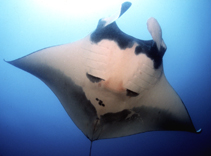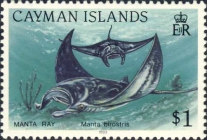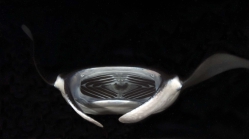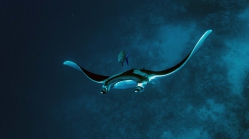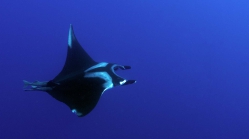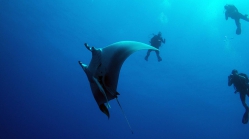WoRMS name details
Manta birostris (Walbaum, 1792)
105857 (urn:lsid:marinespecies.org:taxname:105857)
unaccepted
Species
Manta Bancroft, 1829 accepted as Mobula Rafinesque, 1810
marine, brackish, fresh, terrestrial
(of Raja birostris Walbaum, 1792) Walbaum, J. J. (1792). Petri Artedi sueci genera piscium. In quibus systema totum ichthyologiae proponitur cum classibus, ordinibus, generum characteribus, specierum differentiis, observationibus plurimis. Redactis speciebus 242 ad genera 52. Ichthyologiae pars III. <em>Ant. Ferdin. Rose, Grypeswaldiae [Greifswald].</em> Part 3: [i-viii] + 1-723, Pls. 1-3. [details]
Description Mainly oceanic (Ref. 7251) but also encountered in surface or mid-waters of lagoons, shallow muddy bays, off river mouths,...
Distribution Gulf of Maine to Brazil, and occasionaly further north
Description Mainly oceanic (Ref. 7251) but also encountered in surface or mid-waters of lagoons, shallow muddy bays, off river mouths, and seaward reefs. Occurs singly or in small groups (Ref. 1602). Mainly plankton feeders, but may feed on small and moderate-sized fishes as well (Ref. 9911). Mantas are not aggresive but are dangerous because of their rough skin and huge size which has led to the deaths of deep-sea divers whose airlines have been entangled with these creatures. May be captured by means of the harpon. Leaps out the water every once in a while. [details]
Distribution Gulf of Maine to Brazil, and occasionaly further north
Distribution Gulf of Maine to Brazil, and occasionaly further north [details]
Froese, R. and D. Pauly. Editors. (2024). FishBase. Manta birostris (Walbaum, 1792). Accessed through: World Register of Marine Species at: https://www.marinespecies.org/aphia.php?p=taxdetails&id=105857 on 2024-09-19
Date
action
by
![]() The webpage text is licensed under a Creative Commons Attribution-Noncommercial 4.0 License
The webpage text is licensed under a Creative Commons Attribution-Noncommercial 4.0 License
original description
(of Raja birostris Walbaum, 1792) Walbaum, J. J. (1792). Petri Artedi sueci genera piscium. In quibus systema totum ichthyologiae proponitur cum classibus, ordinibus, generum characteribus, specierum differentiis, observationibus plurimis. Redactis speciebus 242 ad genera 52. Ichthyologiae pars III. <em>Ant. Ferdin. Rose, Grypeswaldiae [Greifswald].</em> Part 3: [i-viii] + 1-723, Pls. 1-3. [details]
context source (HKRMS) Hong Kong marine fish database. <em>AFCD.</em> , available online at https://www.hk-fish.net/en/fish/introduction/ [details]
context source (Bermuda) Smith-Vaniz, W. F.; Collette, B. B.; Luckhurst, B. E (1999). Fishes of Bermuda: History, zoogeography, annotated checklist, and identification keys (American Society of Ichthyologists and Herpetologists - Special Publication No.4) . ASIH, 424 pp. [details]
basis of record van der Land, J.; Costello, M.J.; Zavodnik, D.; Santos, R.S.; Porteiro, F.M.; Bailly, N.; Eschmeyer, W.N.; Froese, R. (2001). Pisces, <B><I>in</I></B>: Costello, M.J. <i>et al.</i> (Ed.) (2001). <i>European register of marine species: a check-list of the marine species in Europe and a bibliography of guides to their identification. Collection Patrimoines Naturels,</i> 50: pp. 357-374 (look up in IMIS) [details]
additional source Collette, B. B., ; Klein-MacPhee, G. (2002). Bigelow and Schroeder's Fishes of the Gulf of Maine. <em>Smithsonian Institution Press.</em> 1-748. [details]
additional source Florida Museum of Natural History. 2003. Ichthyology Collection Database., available online at http://www.flmnh.ufl.edu/fish/Collection/collectdata.htm [details]
additional source Welshman, D.; Kohler, S; Black, J.; and L. Van Guelpen. (2003). An atlas of distributions of Canadian Atlantic fishes. , available online at http://epe.lac-bac.gc.ca/100/205/301/ic/cdc/FishAtlas/default.htm [details]
additional source McEachran, J. D. (2009). Fishes (Vertebrata: Pisces) of the Gulf of Mexico, Pp. 1223–1316 in: Felder, D.L. and D.K. Camp (eds.), Gulf of Mexico–Origins, Waters, and Biota. Biodiversity. Texas A&M Press, College Station, Texas. [details]
additional source Liu, J.Y. [Ruiyu] (ed.). (2008). Checklist of marine biota of China seas. <em>China Science Press.</em> 1267 pp. (look up in IMIS) [details] Available for editors [request]
[request]
additional source Froese, R. & D. Pauly (Editors). (2023). FishBase. World Wide Web electronic publication. version (02/2023)., available online at https://www.fishbase.org [details]
context source (HKRMS) Hong Kong marine fish database. <em>AFCD.</em> , available online at https://www.hk-fish.net/en/fish/introduction/ [details]
context source (Bermuda) Smith-Vaniz, W. F.; Collette, B. B.; Luckhurst, B. E (1999). Fishes of Bermuda: History, zoogeography, annotated checklist, and identification keys (American Society of Ichthyologists and Herpetologists - Special Publication No.4) . ASIH, 424 pp. [details]
basis of record van der Land, J.; Costello, M.J.; Zavodnik, D.; Santos, R.S.; Porteiro, F.M.; Bailly, N.; Eschmeyer, W.N.; Froese, R. (2001). Pisces, <B><I>in</I></B>: Costello, M.J. <i>et al.</i> (Ed.) (2001). <i>European register of marine species: a check-list of the marine species in Europe and a bibliography of guides to their identification. Collection Patrimoines Naturels,</i> 50: pp. 357-374 (look up in IMIS) [details]
additional source Collette, B. B., ; Klein-MacPhee, G. (2002). Bigelow and Schroeder's Fishes of the Gulf of Maine. <em>Smithsonian Institution Press.</em> 1-748. [details]
additional source Florida Museum of Natural History. 2003. Ichthyology Collection Database., available online at http://www.flmnh.ufl.edu/fish/Collection/collectdata.htm [details]
additional source Welshman, D.; Kohler, S; Black, J.; and L. Van Guelpen. (2003). An atlas of distributions of Canadian Atlantic fishes. , available online at http://epe.lac-bac.gc.ca/100/205/301/ic/cdc/FishAtlas/default.htm [details]
additional source McEachran, J. D. (2009). Fishes (Vertebrata: Pisces) of the Gulf of Mexico, Pp. 1223–1316 in: Felder, D.L. and D.K. Camp (eds.), Gulf of Mexico–Origins, Waters, and Biota. Biodiversity. Texas A&M Press, College Station, Texas. [details]
additional source Liu, J.Y. [Ruiyu] (ed.). (2008). Checklist of marine biota of China seas. <em>China Science Press.</em> 1267 pp. (look up in IMIS) [details] Available for editors
additional source Froese, R. & D. Pauly (Editors). (2023). FishBase. World Wide Web electronic publication. version (02/2023)., available online at https://www.fishbase.org [details]
 Present
Present  Present in aphia/obis/gbif/idigbio
Present in aphia/obis/gbif/idigbio  Inaccurate
Inaccurate  Introduced: alien
Introduced: alien  Containing type locality
Containing type locality
From other sources
Description Mainly oceanic (Ref. 7251) but also encountered in surface or mid-waters of lagoons, shallow muddy bays, off river mouths, and seaward reefs. Occurs singly or in small groups (Ref. 1602). Mainly plankton feeders, but may feed on small and moderate-sized fishes as well (Ref. 9911). Mantas are not aggresive but are dangerous because of their rough skin and huge size which has led to the deaths of deep-sea divers whose airlines have been entangled with these creatures. May be captured by means of the harpon. Leaps out the water every once in a while. [details]Diet Feeds mainly on plankton, may consume small fishes [details]
Distribution Gulf of Maine to Brazil, and occasionaly further north [details]
Habitat nektonic [details]
Habitat Found to depths of 24 m, mainly in nearshore waters, around coral reefs . [details]
Importance Social - Minor commercial fishery [details]
Predators Sharks [details]
Reproduction Internal fertilization; ovoviviparous [details]
| Language | Name | |
|---|---|---|
| English | mantagiant mantaAtlantic manta | [details] |
| French | mante géante | [details] |
| German | Mantarochen | [details] |
| Japanese | オニイトマキエイ | [details] |
| Lithuanian | didžioji manta | [details] |
| Polish | manta | [details] |
| Russian | манта | [details] |
| Slovenian | manta | [details] |
| Spanish | mantarrayamanta gigante | [details] |
| Turkish | manta vatozu | [details] |
| Ukrainian | Манта | [details] |
| Welsh | manta | [details] |
To Barcode of Life (25 barcodes)
To Biodiversity Heritage Library (115 publications)
To Biological Information System for Marine Life (BISMaL)
To Digital Atlas Of Marine Species & Locations, DAMSL (Giant Manta Ray)
To Digital Atlas Of Marine Species & Locations, DAMSL (Giant Manta Ray)
To Digital Atlas Of Marine Species & Locations, DAMSL (Giant Manta Ray)
To Digital Atlas Of Marine Species & Locations, DAMSL (Giant Manta Ray)
To Digital Atlas Of Marine Species & Locations, DAMSL (Giant Manta Ray)
To Digital Atlas Of Marine Species & Locations, DAMSL (Remoras cleaning Giant Manta Ray)
To FishBase
To FishBase images (Manta birostris, Mozambique, by Marshall, A.)
To Global Biotic Interactions (GloBI)
To PESI
To ITIS
To Biodiversity Heritage Library (115 publications)
To Biological Information System for Marine Life (BISMaL)
To Digital Atlas Of Marine Species & Locations, DAMSL (Giant Manta Ray)
To Digital Atlas Of Marine Species & Locations, DAMSL (Giant Manta Ray)
To Digital Atlas Of Marine Species & Locations, DAMSL (Giant Manta Ray)
To Digital Atlas Of Marine Species & Locations, DAMSL (Giant Manta Ray)
To Digital Atlas Of Marine Species & Locations, DAMSL (Giant Manta Ray)
To Digital Atlas Of Marine Species & Locations, DAMSL (Remoras cleaning Giant Manta Ray)
To FishBase
To FishBase images (Manta birostris, Mozambique, by Marshall, A.)
To Global Biotic Interactions (GloBI)
To PESI
To ITIS
